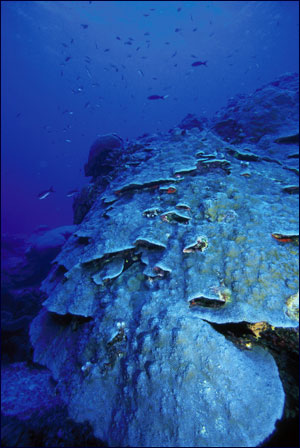Flower Garden Banks National Marine Sanctuary Listed as a SPAW Special Protected Area
On October 27, 2012, during the Twelfth Meeting of the Contracting Parties to the Convention for the Protection and Development of the Marine Environment of the Wider Caribbean Region (Cartagena Convention) three marine protected area sites proposed by the U.S. were formally listed under the Special Protected Areas and Wildlife (SPAW) Protocol. These new US SPAW Protocol sites are Flower Garden Banks National Marine Sanctuary, and the Florida Everglades and Dry Tortugas National Parks. They join the Florida Keys National Marine Sanctuary and 14 international sites that are listed under the SPAW Protocol.
 The SPAW Protocol (in-force 2000) is part of the Cartagena Convention (in-force 1986). In signing the SPAW Protocol, the U.S. committed to take the necessary measures to protect, preserve and sustainably manage areas that require conservation to safeguard their special value, and threatened or endangered species of flora and fauna. Such areas include representative habitats, critical habitats, economically and/or socially valuable areas, and areas of special significance within the Wider Caribbean region. At their first meeting in 2001, the Contracting Parties (COP) to the SPAW Protocol agreed to develop guidelines and criteria for the evaluation of protected areas to be listed under the SPAW Protocol. The Office of National Marine Sanctuaries Southeast, Gulf of Mexico and Caribbean Region assisted with the development and review of these criteria. The Parties also decided at that time to initiate the listing process through a pilot project to help assess the guidelines and criteria, as well as the format for listing. The Florida Keys National Marine Sanctuary was listed as part of this pilot project. The SPAW Protocol (in-force 2000) is part of the Cartagena Convention (in-force 1986). In signing the SPAW Protocol, the U.S. committed to take the necessary measures to protect, preserve and sustainably manage areas that require conservation to safeguard their special value, and threatened or endangered species of flora and fauna. Such areas include representative habitats, critical habitats, economically and/or socially valuable areas, and areas of special significance within the Wider Caribbean region. At their first meeting in 2001, the Contracting Parties (COP) to the SPAW Protocol agreed to develop guidelines and criteria for the evaluation of protected areas to be listed under the SPAW Protocol. The Office of National Marine Sanctuaries Southeast, Gulf of Mexico and Caribbean Region assisted with the development and review of these criteria. The Parties also decided at that time to initiate the listing process through a pilot project to help assess the guidelines and criteria, as well as the format for listing. The Florida Keys National Marine Sanctuary was listed as part of this pilot project.
Eligible sites for listing under the SPAW Protocol are those coastal and marine areas that are ecologically important to the Wider Caribbean region. The listing of marine protected areas is done to sustain the natural resources of the Wider Caribbean region, and to encourage ecologically sound and appropriate use, understanding and enjoyment of the areas. Ultimately, sites listed will contribute to a comprehensive and representative system network of protected areas in the Wider Caribbean region, across all bioregions and across the range of ecosystems within each bioregion.
The Objectives of SPAW
- To significantly increase the number and improve the management of national protected areas and species in the Wider Caribbean Region (WCR), including support to national and regional conservation and management strategies and plans, where appropriate.
- To develop strong regional capability for the co-ordination of information exchange, training and technical assistance, in support of national biodiversity conservation efforts.
- To coordinate activities with the secretariat of the Convention on Biological Diversity, as well as other biodiversity-related treaties, such as the CITES, Ramsar, World Heritage, Bonn and Western Hemisphere Conventions.
The commitments by the Contracting Parties to SPAW
- To take the necessary measures to protect, preserve and manage in a sustainable way areas that require protection to safeguard their special value.
- To regulate and, where necessary, prohibit activities having adverse effects on these areas.
- To establish protected areas, some of which need not necessarily become “listed” areas within the SPAW network.
- To sustain the natural resources of the Wider Caribbean Region, in particular (a) representative ecosystem types; (b) habitats critical to the survival and recovery of endangered, threatened or endemic species; (c) the productivity of ecosystems and natural resources; and (d) areas of special biological, cultural, or other special interest.
The pilot project was completed in 2010 – 2011 to list MPAs under SPAW using the Annotated Format detailed in the Guidelines for listing protected areas. This pilot resulted in the listing of the following areas:
Belize:
Hol Chan Marine Reserve
Glover's Reef Marine Reserve
Colombia:
Sanctuary Cienaga Grande de Santa Marta
Regional Seaflower Marine Protected Area in San Andrés and Providencia Archipelago
France:
Grand Connétable Island Nature Reserve (French Guyana)
Guadeloupe National Park (Grand Cul de Sac Marin)
US:
Florida Key National Marine Sanctuary
Netherlands Antilles:
Bonaire National Marine Park
National Park the Quill and Boven on St. Eustatius
The latest sites to become part of SPAW are:
US:
Flower Garden Banks National Marine Sanctuary
Everglades National Park
Dry Tortugas National Park
Cuba:
Guanahacabibes National Park in Pinar del Río
Saba (Netherlands):
Saba Bank National Park
St Martin (France):
St Martin National Reserve
St Martin Lagoon Ponds
Guadeloupe (France):
Petite-Terre National Reserve
French West Indies (France):
Agoa Sanctuary
Click here for more information.
 Full FGBNMS SPAW Protocol Proposal Full FGBNMS SPAW Protocol Proposal
 Full FKNMS SPAW Protocol Proposal Full FKNMS SPAW Protocol Proposal
|



